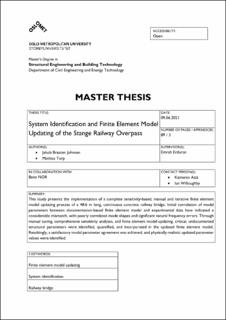System identification and finite element model updating of the stange railway overpass
Master thesis
Published version
Permanent lenke
https://hdl.handle.net/11250/2773932Utgivelsesdato
2021Metadata
Vis full innførselSamlinger
Sammendrag
This study presents the implementation of a sensitivity-based finite element model updating process on a 48.6 m long, continuous, concrete railway bridge located in Stange, Norway. Lack of documentation and uncertainties surrounding the structural system and dynamic responses have prompted the need for system identification and development of an updated finite element model that can more accurately represent the as-built structure.
The railway bridge under investigation was instrumented to perform system identification, and operational condition output-only vibration data was collected. Using the Covariance-driven Stochastic Subspace Identification method implemented in MATLAB, four dominant, distinct, and recurring modes were identified. By developing a simplified, documentation-based initial finite element model and performing modal analysis, significant discrepancies between the experimentally and analytically identified modal parameters were observed. Correlation of experimental and initial analytical modal parameters gave an average mode shape correlation of 61 % and average natural frequency error of 23.7 %, indicating a considerable mismatch between the documented and as-built structure. With observations made through visual inspections, undocumented changes to the structure were identified, confirming this mismatch. Through the implementation of these changes in the initial finite element model, manual tuning, comprehensive sensitivity analyses, and manual iterative finite element model updating, the errors between the experimental and analytical modal parameters were successfully minimized. The average mode shape correlation was increased to 89 %, and the natural frequency error was reduced to 9.8 %, indicating a very good modal parameter agreement between the experimental and analytical results.
This study has successfully identified and implemented an effective and complete method of finite element model updating applicable for railway bridges. Critical structural parameters have been identified, and their influence on the modal parameters and dynamic behavior has been thoroughly investigated. The manual finite element model updating process has generated indispensable first-hand knowledge of understanding structural systems and dynamic behavior of railway bridges, which, combined with fair engineering judgment, have contributed to the success of this study.
